There’s something humbling about watching a 3-Gun Nation pro series event. It’s not that it’s hallowed ground or anything, but when I cover them, I really get a sense of how much better shooters at that level are compared to those at my lowly place on the totem pole. Stages that would give me fits, the big guys seem to breeze through, making it look effortless. Being embedded with the team for the year is giving me some rather unique insights into how the shooters on Team FNH USA break down a stage and plan their strategy. I wanted to share some of what I picked up after watching the big boys shoot the first match of the 3-Gun Nation Pro Series . . .
First off, special thanks to Chad at 3-Gun Nation for handing me copies of the CAD version of the stages. It makes things a lot easier to understand if you can visualize the overall stages rather than just watching the video.
Stage 1 was a zig-zag course that involved “long range” steel and a lot of running before some close range shotgun and pistol work. The stage was designed with the 180 in mind: all targets were downrange of the start position and were downrange of the line the shooters needed to run. It was a nice touch, especially since I’ve seen way too many DQ’s from people breaking the 180 line recently. Shooters start the stage with a loaded rifle staged in front of them, a loaded shotgun on a table on the right side of the course, and their handgun cruiser ready (loaded magazine, empty chamber).
This stage is actually an anomaly in the pro series – as Larry Houck says, the targets are usually very close-range to make it look fast and exciting for the camera. This stage, though, started off with some longer than normal range targets that required quick work with the rifle. The trick was figuring out where to take the shot. Not all steel could be engaged from the start position, so the shooter needed to move to a different spot and engage the other targets at least once before ditching the rifle.
This presented a challenge, because it takes a (relatively) long time to stop, set up for a shot and then get moving again. Momentum is working against you the whole time and it eats away the seconds quickly. Shooters want to keep interruptions to a minimum, especially during stages that require a long sprint like this one. The winning combination seemed to be to take a couple shots across the bay at a couple of the visible targets, then shoot the close ones near that first turn while moving toward it. Then, about halfway down the track there’s a spot where the other targets become visible. Most people stop there, then book it for the shotgun and dump barrel. That keeps the number of interruptions to their sprinting to a minimum, resulting in a faster time.
From there, the stage gets fairly ordinary. Shotgun the steel targets until they fall, then dump it, grab your handgun and engage the targets as they appear. *yawn* It’s technically challenging, in that you have to have the right technique to hit everything. Just not exactly mentally challenging.
Stage 2 is where we start getting into the strategy of firearms selection. It’s designed to start with a loaded rifle that then gets dumped for a shotgun, and finally ends with some handgun targets.
The first part of the course of fire is predictable: hammer the targets in front of the table with the rifle, then flip around and do the same to the two behind you. Then move to the far right side where you have a hidden target that can only be engaged from the right side of that screen in the middle of the stage. That’s where the shooter has the first option.
Before you dump your rifle, you can see five additional targets at the end of the course: two on the left peeking out from behind a screen, one in the middle, and two on the right. There are three that aren’t visible and require some handgun work, but that’s where the option comes in. You have to go down there anyway, there’s no avoiding it. So do you hit those targets from ~30 yards away with the rifle before you dump it, or do you dump the rifle quickly and have to reload your handgun?
This is where it’s handy to know how fast you’re able to do things. Many shooters recommend timing how long it takes to do the building blocks of a stage – reload your handgun, draw from a holster, transition between targets with various firearms — so that if you know how fast you can hit a target at 30 yards, you can figure out if it makes sense to use the larger ammo capacity of the rifle or simply reload the handgun while moving downrange. Know thyself, know your enemy and all that.
Another factor in the decision is your ability to remember which targets you’ve shot and which you haven’t. Things tend to get a bit mentally hairy in the middle of the stage, and having to visually identify which targets have been shot takes up valuable time. If you’re able to remember which ones still need shooting in the middle of all that adrenaline, that would make the rifle option look more appealing.
There were different ways of running this one. Kay Miculek shot the visible targets with a rifle before ditching it, and only hit the remaining ones with a handgun. Mark Hamish took the “screw it, we’ll do it live” approach and went all handgun on those targets. Again, it all depends on your preferences.
The more interesting option on this stage was choosing when to dump the shotgun. You’re required to swap the rifle for a shotgun at that first dump barrel (where the shooting area makes a straight line for the berm) because the next few targets are clay pigeons. And per the rulebook, they’re only shot with a scattergun – not that anyone would really want to use something different.
The small square steel targets conveniently located next to the shotgun dump barrelm though, are shooter’s choice, either shotgun or handgun. Adding in another interesting wrinkle is the handgun start position. Because the handgun is “cruiser ready” and not loaded, it takes an extra split second to rack the slide before firing your first shot.
This is another place where knowing how well you perform with different guns is a big advantage. Shotguns are quicker to aim and fire, but using one means that you’ll need to reload the mag tube; you expend most of your ammo on the clay pigeons. Larry’s thought on options like this is that the “load two” method of shotgun reloads actually makes it faster to reload the gun and use the shotgun rather than taking the time to dump the shotgun, load the handgun and hit the targets. Add in the fact that the whole thing’s being recorded for TV and that a shotgun gives you a bit more wiggle room when it comes to accuracy and it becomes the more appealing choice.
Again, different people shot this section differently depending on their strengths. Maggie Reese agreed with Larry’s read and reloaded her shotgun for the steel targets. Lena Miculek disagreed and used her handgun for those targets. Of course, being the daughter of the legendary Jerry Miculek, you’d expect her handgun shooting to be her strong suit.
Stage 3 was my second favorite of the day, and the reason is that it is decidedly evil. Start with a loaded rifle for some paper targets, then a little shotgun shooting down the center, ending with some handgun paper targets at the end of the bay.
It looks simple enough, but that’s deceptive. There are two sets of rifle targets, one set down the right side and one down the left. They’re identical, but there’s catch. The longer range paper targets can only be engaged from the far corners of that triangle, forcing shooters to visit both corners. And from each of those spots, only the opposite side’s close range targets are visible. They’re also visible when moving downrange, but then the 180 rule becomes a concern.
The first option is how you want to shoot those close range paper targets. Do you hit them from the corner or do you take them on the move while going downrange? You’re going to be at both corners no matter what you do, so the distance you’re moving your fat ass won’t change much. The only variable is how far away the targets are, and how fast you’re going when you finally move forward.
There’s the real decision: is it faster to shoot the targets from 10 yards and sprint to the dump barrel, or slowly “duck walk” past them at two yards? In reality it appeared to be a wash. For me, I’d prefer to shoot them from the corners and book it. That’s the line that Mark Hamish used. Then again, he also launched his rifle at the dump barrel from a good 10 feet away (arms flailing as he went to grab the shotgun, pretty hilarious in the video actually), and I’m not exactly that confident in my abilities to hit the basket.
The next segment is all shotgun on clay pigeons, but then there’s the second option. And like the previous stage, the choice is to dump the shotgun early and switch to the handgun, or reload the shotgun and take out the small steel targets. They even placed two dump barrels there to accommodate whatever way you choose — one at the end of the clay pigeons for those who want to switch and one at the end of the steel for those who don’t. There were only 8 clay pigeons, so with 9 in the tube you shouldn’t have to reload if you wanted to switch to a handgun. But for those who wanted to stick with a shotgun, you had to feed another eight rounds.
Larry is in love with his load two method, so naturally he went with the shotgun. As someone who sucks at handgun shooting, I tend to agree. The splits between targets (how long it takes to break the shot, move on to the next target, and take another shot) are much faster with the shotgun, and the probability of missing is greatly reduced. But, if you can’t load your shotgun quickly you’re sunk.
The stage ends with some more boring handgun shooting that, again, was all about technique.
Stage 4 was ordinary from a strategy perspective, but turned out to be very challenging technically. You begin with your handgun holstered, cruiser ready, and on the buzzer take out the paper targets and small steel. Then you transition to the shotty, finally dumping it for the rifle at the end of the run.
The challenge comes when you start getting close to that 180 line. One of the shooters was disqualified on this stage because he broke that rule, continuing to shoot at a stubborn handgun target that refused to fall even after he’d passed it. That’s one of the things you always need to remember when shooting 3-gun: situational awareness. There are moments when you focus on one specific target so intently that you forget everything else. Those moments that can get you into trouble. So take note: stay aware of where that 180 line is and stay clear.
Stage 5 was, without a doubt, my favorite of the day because it presented the most options. You start on the left side at the large table. On the signal you can engage the targets however you want. There are seven paper targets separated by screens in the middle of the stage that make it impossible to shoot them without being on one side of the screen or the other. Then, at the far end of the left bay were some clay pigeons that needed to be hit with a shotgun and some steel targets for either shotgun or handgun. Finally, on the right side of the bay are paper targets that could be taken with either handgun or rifle.
There was no defined way to shoot the stage. Each person made it up as they went along. Shotgun or handgun on the steel? Handgun or rifle on the paper? Which table do you want to use to stage your rifle? It was all up to you.
The “default” way of running the stage was handgun from the start on the close paper, then running down the opposite side of the bay for those targets, and shooting the paper and steel at the end of the stage before switching to the shotgun. You tear-ass around the corner for the rifle and take out the rest of the targets as they come.
Larry did it a little differently. And by that, I mean almost REALLY differently. Instead of running his handgun on the steel targets, he dumped it at the first opportunity for his beloved shotgun. Then, he switched to the rifle at the end of the first bay instead of staging it at the entrance to the second. To him, that just made more sense. Like I said, I generally agree with Larry’s view that running a shotgun using “load two” reloads makes you faster than the handgun, and on this stage it really proved out.
The last stage was the shoot-off stage. The top five competitors at the end of the day ran an additional stage to determine who walked away with the grand prize for the day, and they didn’t make it easy. You started with a loaded shotgun, cruiser ready handgun holstered, and a rifle staged on one of the tables. The first section was clay pigeons, then some steel targets, and finishing off with rifle.
The same option that kept popping up again and again made its final appearance of the day here: the choice of switching to a handgun or sticking with the shotgun for the steel targets. Again, you should have one round left after the clay pigeons if you do things right, but, of course, there’s a twist. You don’t really need the handgun after the steel targets, so there’s no reload coming down the road. The rest of the targets are all rifle targets. In the end, it simply boils down to which gun you’re more comfortable with.
As for the rifle targets, the challenge was finding the least number of positions you need to stop at in order to hit all the targets. There were two staggered sets of screens, making it impossible to hit all of the paper targets from one or even two positions. At a bare minimum, you needed to move to the extreme edges of the shooting area, and then two intermediate positions that were up to the shooter.
The 3-Gun Nation stages really have gotten miles better than they were. The first year I watched, they were more fixed – you didn’t have as many options as to how to run them. But with some input from the shooters, they’re starting to get more strategy-based than simple “hose ‘em down” designs. And for me, that makes it even more exciting to watch.

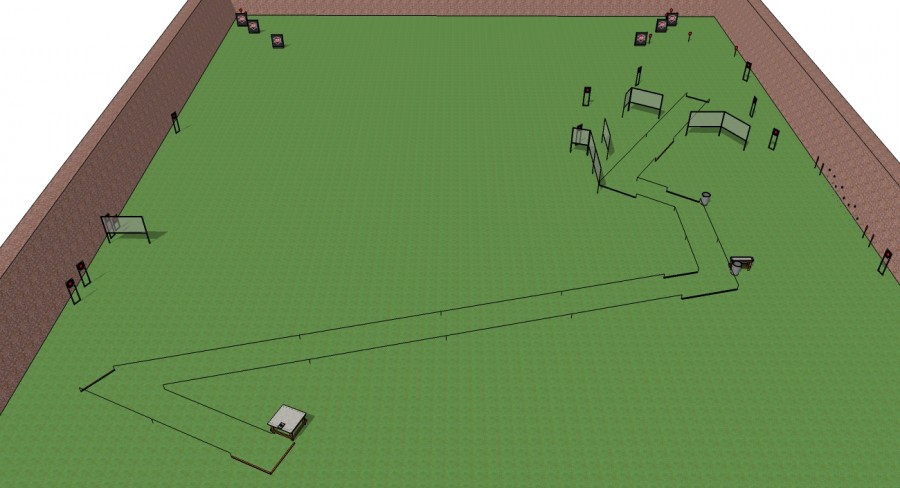
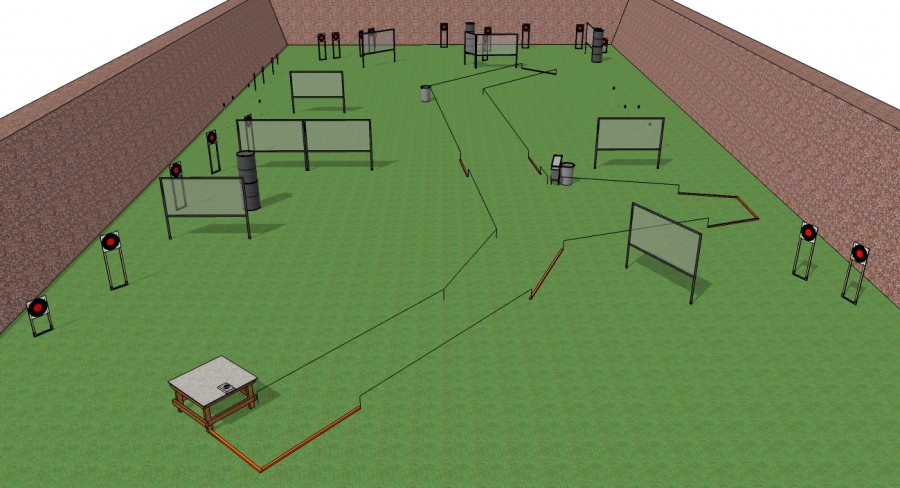
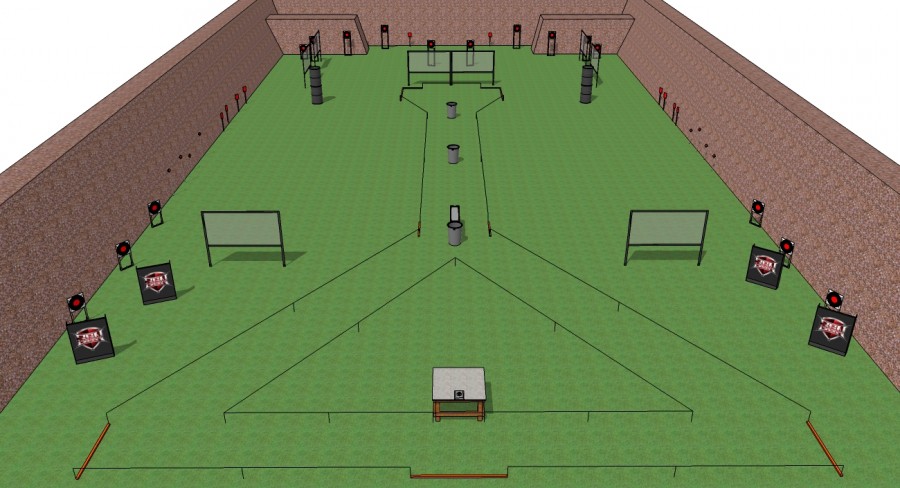
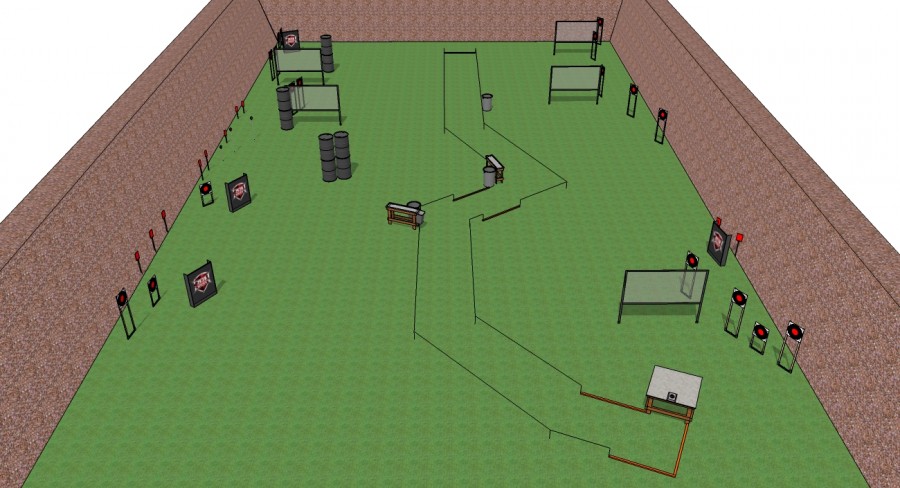
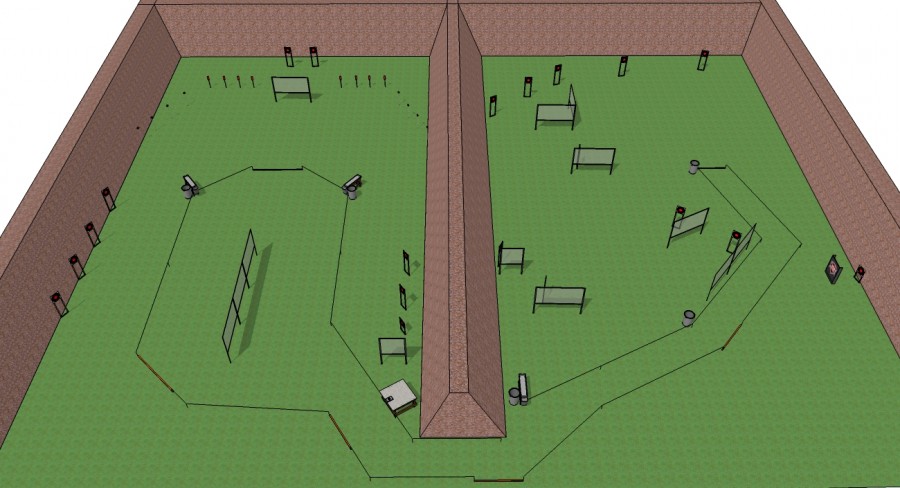
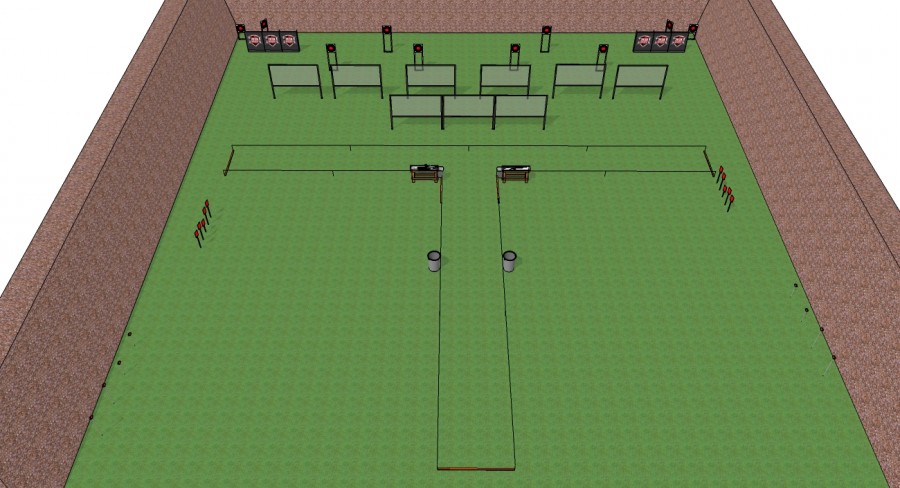
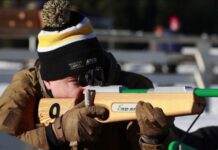


Wow Nick, thanks for the visuals, it makes a whole lot more sense when you cans see the full layout like that. Out of curiosity… (And a bit OT) where is the SAIGA and AK hate coming from in the 3gun community?
Nick –
Thanks so much for writing about this. It seems way more fun than than typical target shooting. Where can we find videos of 3-Gun competitions?
Keep ‘me coming nick! The CAD drawings are a real nice touch!!!
The CAD maps of the courses are both fascinating and intimidating. While I consider myself a basic, competent shooter, I don’t think I’d have the first clue about the best way to strategize the sequence of shots. I guess selection is a matter both of skill and experience.
Comments are closed.